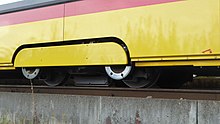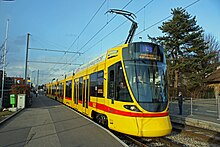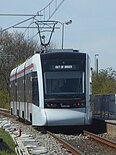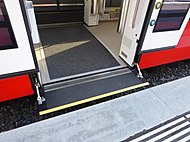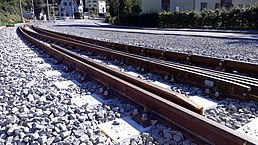Stadler Tango
| Stadler Tango | |
|---|---|
|
Tango by Baselland Transport (BLT) near Ettingen
|
|
| Number: | 165 |
| Manufacturer: | Stadler Rail |
| Year of construction (s): | from 2007 |
| Axis formula : | → Overview of variants |
| Gauge : | 1000 mm , 1435 mm |
| Length over coupling: | 27.0 ... 52.6 m |
| Height: | 3.51 ... 3.72 m |
| Width: | 2.30 ... 2.65 m |
| Smallest bef. Radius: | 12 ... 50 m |
| Empty mass: | 38.3 ... 87.0 t |
| Top speed: | up to 100 km / h |
| Continuous output : |
per driven axle: 110… 175 kW |
| Driving wheel diameter: | 650… 740 mm |
| Impeller diameter: | 560… 740 mm |
| Power system : | 600 ... 1500 V = |
| Seats: | 66… 147 |
| Standing room: | 75… 218 |
| Floor height: | 320… 1000 m |
| Low floor: | 0… 100% |
| Particularities: | Air suspension |
| see also overview of variants | |
The Stadler Tango is a product group of three to six-part modular urban and tram vehicles from the manufacturer Stadler Rail .
The Tango tram family was developed by Stadler Rail based on the Be 4/6 of the Forchbahn and the simultaneously built Be 4/8 of the Trogenerbahn as well as the experience with the Variobahn taken over by Adtranz . The vehicles are characterized by a variable low-floor section and conventional bogies , which allow comfortable running characteristics, low maintenance requirements and a top speed of up to 100 km / h. Accordingly, the Tango can also be used outside of cities on regional routes.
history

Starting with the GTW family, Stadler Rail built the multiple units Be 4/6 for the Forchbahn and Be 4/8 for the Trogenerbahn - which today form a section of the Appenzeller Bahn . The vehicles, which went into operation in 2004, operate in the inner city of Zurich and St. Gallen according to the rules of tram traffic, but outside of the city they run on their own track with increased overhead line voltage as a railway. When the Bochum-Gelsenkirchen trams (Bogestra) commissioned six standard-gauge high - floor trams in 2005 , Stadler developed the multiple units of the two Swiss meter -gauge railways into the Tango tram family. Many parts were used in the Tango with pantographs , doors, controls, seats and flooring that are also used in the Variobahn . The Bogestra ordered 30 of this type along with the Tango.
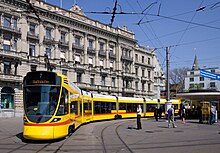
In 2006 Baselland Transport (BLT) and Basler Verkehrs-Betriebe (BVB) signed a framework agreement with Stadler for a 52-meter-gauge Tango. Four pre-series vehicles were extensively tested on the BLT and BVB network in 2009. Thereafter, BLT ordered 15 series vehicles, while BVB withdrew from the framework agreement. The BLT Tango 154 stayed a few weeks in March and April 2009 before it was delivered to its owner at the Zurich Transport Authority (VBZ), where it was tested in passenger service on line 7. Experiences from the trial operation and the passenger surveys should flow into the tender for the next generation of trams of the VBZ, which from 2013 should replace the remaining "Mirage" and the first generation of the Tram 2000 . After the Zurich-based company had also tested trams from other manufacturers, they opted for completely low-floor vehicles. The announcement of the award decision was delayed and turned into an affair . When Bombardier won the bid in 2016 , Siemens and Stadler filed a complaint , which was refused suspensive effect in February 2017 .
In contrast, Stadler achieved sales success in Geneva when Transports publics genevois (TPG) ordered 32 Tangos in January 2010, which are very similar to BLT vehicles. In 2014 it became known that Stadler could supply the rolling stock for the planned Aarhus light rail system in Denmark. As in Bochum, the order consisted of Variobahn and Tango vehicles. For the operation of the new diameter line , the Appenzeller Bahnen received eleven six-part two-voltage Tango in 2018, which, in contrast to the BLT and TPG trains, can be divided in the middle.
In 2016, Stadler received an order from the Czech city of Ostrava to supply 40 low-floor trams. While in the Czech media vehicles of the Russian broad gauge developed type market Metelitsa was reported Stadler speaks of "Adapted type Tango" and emphasizes the technical relationship between the two types of vehicles. Political reasons may also have played a role in determining the name.
technical description
The Tango-tram is as input or bidirectional vehicle with a box width of 2.3 to 2.65 meters and a longitudinal compressive strength of 200 to 600 kN for normal or meter gauge available. Initially, the vehicles were built entirely with high floors or, because of the bogies, with 60 to 75% low floor . In 2017, complete low-floor vehicles were then delivered to Aarhus . The Tango-Tram with conventional bogies is much cheaper to operate than completely low-floor trams with single-wheel chassis .
Mechanical part



The car bodies are as in the Variobahn in differential construction of stainless steel running supplemented with milled parts for receiving the ring gears and joints . The roof plates are made of stainless steel . The cladding with aluminum sheets between the windows and above the window band is glued on with an air gap that forms the outermost link of the insulation. To minimize repairs after collisions with road vehicles, the lower side wall panels and the front aprons are attached with screw fixings. The driver's cab consists of a supporting steel frame and GRP cladding. The front aprons have a shape that protrudes deep down so that in the event of a collision, the pedestrian is caught under his body's center of gravity and thrown up or to the side in order to avoid a tragic rollover. To meet the more stringent crash norms , the headjoints of the Tangos destined for Geneva were for the first time given a welded circumferential parapet .
As with the GTW , the car bodies are attached to the neighboring modules, which saves weight and increases the low-floor area. At higher speeds , dampers between the individual wagon parts prevent rolling movements , keep the short intermediate modules in track curves largely in the bisector and reduce lateral acceleration when entering and leaving the curve. Cross dampers dampen and limit the sway of the short-trailers, Lemniskatenlenker hold when driving over crests and troughs in the bisecting line. The six-part Basel and Geneva Tangos have a Jakobs motorized bogie in the middle with a double slewing ring on which two middle modules are attached.
The Tango is based on various components that have already been used in Stadler's own GTW and Flirt product families . In contrast to the Variobahn, the Tango is based on bogies with one or two roll stabilizers and a classic H-frame, which, in addition to the good suspension comfort, is gentle on the tracks. The motorized bogies come from the Be 4/6 of the Forchbahn and the Be 4/8 of the Trogenerbahn and have slewing rings . The running bogies can only deflect a little. in order to obtain the largest possible low-floor area. Like the chassis of the GTW drive modules, they are connected to the boxes of the short intermediate modules with Flexicoil springs . The secondary suspension has so far only been designed as air suspension , although the use of steel springs would also be possible. A wheel flange lubrication system is installed on the leading bogies and a sand spreading device is installed on the front axles of the motor bogies .
Drive and brakes
The converters and the auxiliary systems are based on the same components as in the Variobahn. Each motor bogie has its own traction part with an inverter for each drive motor, which shortens the cable routing. The hollow shafts braces the two traditional three-phase asynchronous motors , each motor bogie ensures good suspension and driving characteristics. The control system , which also functions as anti- skid protection and anti-skid protection for the electric brake, is redundant . In the event of a fault, a second vehicle control unit takes over the entire function.
Like the Variobahn, the Tango is equipped with three independent braking systems. An electric brake is used as the service brake and works almost to a standstill. When the power grid is receptive, it works as a recuperation brake and otherwise as a drag brake . In the event of poor adhesion , the disc brake of the wheel sets is also used, which can be designed as a compressed air or hydraulically operated brake . The magnetic rail brake, which is automatically triggered when the vehicle is braked, can also be operated manually by the driver.
Operator and areas of application
Bochum-Gelsenkirchen trams
The Bochum-Gelsenkirchen trams (Bogestra) were the first customers to order Tango trams from Stadler in Pankow . The six bidirectional vehicles have been in use in Bochum since 2007 . The 28-meter-long high-floor Tango run mainly in double traction on the U35 light rail line , which is equipped with elevated platforms throughout and 70% of which runs in the tunnel. The three-part standard-gauge vehicles have four entry doors on each side and reach a speed of 80 km / h.
Baselland Transport
After Baselland Transport (BLT) and Basler Verkehrs-Betriebe (BVB) had signed a framework agreement with Stadler Rail for the delivery of up to 60 Tango in 2006, BLT received four pre-production vehicles Be 6/10 151–154, which were im 2008 were extensively tested on the network of BLT and BVB. The meter-gauge tram network in Basel is characterized by extremely narrow curved tracks with a radius of up to 11.8 meters, gradients of up to 80 ‰ and very strong twists. On the periphery there are long overland sections with their own tracks. From November 11th to 14th, 2009, Stadler presented the Be 4/6 154 to the trade fair visitors at the Suissetraffic trade fair in Bern. At the end of November 2009, the BLT Board of Directors approved the order for 15 series vehicles due to the satisfactory course of the test program. The order volume for this first main lot was CHF 74 million. The vehicles were delivered between summer 2011 and 2012.
After BVB's own passenger survey had been commissioned in February 2010, the BVB Board of Directors announced on May 12, 2010 that it was withdrawing from the rolling stock procurement that was carried out jointly with BLT. The real background of BVB for not buying the planned 20 Tango remained in the dark. BVB's criticism of Tango was publicly recognized after the appointment of a new Chairman of the Board of Directors . Meanwhile, according to a customer survey, the BLT made improvements in the passenger area of their Tango. In technical and operational terms, however, the very reliable Tango meet the requirements of the BLT. In June 2013 the BLT ordered a second batch of 19 Tango, which were delivered from March 2015 to September 2016. The vehicles of the second series only differ in details from their predecessors. The front section had to be adapted to the new crash regulations.
Rhônexpress Lyon

In April 2007, the Rhônexpress consortium ordered six two-way Tango with 70 percent low-floor space, which has been serving the route from Part-Dieu station to Lyon Saint-Exupéry airport since August 9, 2010 on behalf of the Rhône department . The standard-gauge airport shuttles are comfortable, air-conditioned and have a top speed of 100 km / h. A special seat was developed in order to be able to offer passengers a high level of comfort on the 25-minute journey.
Transports publics genevois (Geneva)
In December 2010, Transports publics genevois (TPG) ordered 32 Tango trams from Stadler, which are very similar to BLT vehicles. In addition, two options were agreed for a further 14 and 10 vehicles respectively, which will be required in the further course of the tram network expansion. In contrast to the Basel trains, the Geneva Tango are two-way vehicles with only five joints and 44 meters in length. Bi-directional vehicles with doors on both sides are mandatory in the Geneva tram network for the routes to Meyrin and CERN , because they have no turning loops and some stops with a central platform . Unlike initially planned, the Be 6/10 got seven instead of six outer doors on each side. To bridge the large distance between the vehicle and the platform, folding steps similar to those used on the Forchbahn and Trogenerbahn vehicles are used.
The purchase of the partially low-floor Tango is remarkable after the TPG had previously bought 39 fully low-floor Cityrunners . In the expanded Geneva tram network, many sections were created with their own route and long distances between stops, where the use of air-sprung bogies is advantageous. In addition, the Geneva tram network is to be extended across the border into France. On September 16, 2011, the first copy of the first series of 19 copies was delivered to Geneva, which were needed for the Gare Cornavin - Onex - Bernex network expansion and to cover increased demand. In October 2016, TPG received the Be 6/10 1820, the first vehicle in the second series, comprising 13 vehicles.
From July 2012, TPG started using a Tango with supercaps , which stores the energy gained when braking and releases it again when starting off. In addition, in the event of a power failure, the vehicle can travel a few hundred meters without power from the overhead line. TPG and Stadler wanted to test whether energy savings could be achieved with the capacitors that were mounted on the roof and weighed around a ton. In 2019, TPG ordered nine more Tangos by redeeming options.
Stuttgart trams
In December 2009, the Stuttgart trams (SSB) ordered twenty two-part light rail trains from Stadler Pankow for 77 million euros, which are based on the Tango family and correspond to the usual Stuttgart DT 8 light rail vehicles . The standard-gauge bidirectional vehicles were delivered from December 2012. In June 2013, the SSB exercised an option for 20 more vehicles that were delivered between November 2016 and the end of 2017. In September 2017, a third tranche for 20 light rail vehicles was called. The DT 8 reach a top speed of 80 km / h. The interior of the high-floor vehicles appears spacious and bright thanks to the vehicle width of 2.65 meters.
→ see also: Section DT 8.12 / 8.14 / 8.15 in the article SSB DT 8
Berlin subway
The small profile series IK of the Berlin subway was derived from the Tango series . After the successful test phase of the two prototypes delivered to the Berliner Verkehrsbetriebe (BVG) in 2015, eleven additional vehicles were ordered in 2015. Stadler Pankow delivered these in 2017 to strengthen the large-profile fleet on the U5 line . A further 27 four-car trains have been delivered to BVG since April 2018. and primarily used on the U2 small profile line .
Aarhus Letbane
Stadler supplied 14 Variobahn vehicles and 12 three-part Tango to operate the Aarhus Letbane light rail in Denmark, which opened in December 2017 . The Tango trains run on the northern line L 1 to Grenaa . The former railway line was converted and electrified for the operation of the light rail. The standard-gauge bidirectional vehicles with a top speed of 100 km / h meet the special requirements in Aarhus, which result from the combination of overland routes and inner-city operations in the historic city center. Lowered slewing rings and the drives arranged on the outside of the bogies made it possible to achieve a low-floor share of 100 percent for the first time in a Tango. To ensure that the rolling stock of Aarhus Letbane has a uniform appearance, the Tango has been given a new front shape that corresponds to the Variobahn. The gray exterior paint with a touch of blue reflects the proximity of the Aarhus light rail to the sea.
Ostrava
In 2016, Stadler received an order from the Czech city of Ostrava to supply 40 standard-gauge low - floor trams. While Stadler of the "Adapted type Tango" speaks and the technical relationship between the two types of vehicles stresses was in Czech media vehicles of the Russian broad gauge developed type market Metelitsa reported. Political reasons may also have played a role in determining the name.
Appenzell Railways
|
So that the Tango trains can run on both the grooved rails in the city of St. Gallen and the SGA route , wheel tire profiles (blue) are used as in the Karlsruhe model. |
|

Wheel guide of the SGA route (red) with an elevation of 30 mm compared to the SOK
|
|
For the Appenzell – St. Gallen – Trogen , the Appenzeller Bahnen (AB) procured eleven ABe 8/12 for 84 million francs, which are based on the concept of the Tango tram family, but have the comfort of a railway. For use by the AB, Stadler Rail upgraded the Tango from a city rail to an overland railway. The trains have greater crash safety for inner-city traffic and overland operations, as well as car bodies 10 centimeters wider than their predecessors and a first- class compartment . The clearance profile of the 2.40 meter wide car bodies and the 7.70 meter distance between the pivot point of the end car bogie and its vehicle joint are based on the parameters of the Trogenerbahn (TB); on the St. Gallen – Gais – Appenzell (SGA) line, a width of 2.65 meters would be permitted. With the opening of the diameter line, the overhead line voltage of the TB was switched to 1500 volts direct current as with the SGA, but in the inner city area of St. Gallen the voltage of 600 volts remained in place with regard to the intersections with the trolleybuses of the VBSG , so that the ABe 8 / 12 are designed as two-voltage vehicles . Because the horizontal gap at individual stops exceeds the norm, a new folding step with a width of 35 centimeters had to be developed. The 80 ‰ steep Ruckhalde tunnel made it necessary to revise the braking concept.
In order to be able to use the Tango trains on the SGA route, the control arms had to be raised on all points . Because of the different wheel guide heights - 30 millimeters for the SGA and 0 millimeters for the TB - wheel tire profiles are used as in the Karlsruhe model . Because this profile requires reprofiling at least once a year, the AB acquired a wheelset lathe . Compared to those in Basel and Geneva, the AB Tango are designed for a longitudinal compressive strength of 400 instead of 200 kN . The bidirectional vehicles have doors on both sides as well as an additional motor bogie and can be separated in the middle. They consist of the independent half-trains Be 4/6 4001–4011 and ABe 4/6 4101–4111, with the 1st class on the Trogen side. The half-trains are always used in pairs, but the compositions can be split for maintenance, which the AB expect to have advantages in terms of maintenance. On the other hand, the AB did not install toilets. The 2.40 meter wide vehicles are too narrow for a disabled toilet.
In the first few months after the commissioning of the ABe 8/12 there were several interruptions in operation due to the new multiple units. From 19 to 26 October 2018, the traffic between St. Gallen and Appenzell took place with replacement buses, because four of the seven Tango trains delivered at the time were found to have increased wear on the wheelsets . The reason for the excessive wheel wear was an insufficient lubricating film between the rail head and the wheel flanges of the vehicles. The bogies reprofiled the Bremgarten-Dietikon-Bahn workshop due to a lack of capacity . From January 26th to 30th, 2019, operations between St. Gallen and Notkersegg were suspended after power outages on the same section on December 23, 2018 and January 12, 2019. The background to the power outages was excessive overvoltages during electrical braking when the Tango trains pass through the transition from the 1500-volt to the 600-volt network at the castle moat. The cause was a software error on the trains of the Appenzeller Bahnen, which should automatically recognize the voltage change. In 2019, residents complained about the strong noise pollution caused by screeching curves . The AB try to reduce the screeching of curves by optimizing the wheel flange lubrication .
The Appenzeller Bahnen Tango trains are likely to be the last of their type. Stadler light rail trains of the Tramlink type were ordered in 2018 for the Lugano-Ponte-Tresa-Bahn , the Waldenburgerbahn and the Limmattalbahn .
Variant overview
The abbreviations of the railway companies are linked to the corresponding section in the chapter Operators and areas of application .
| Stadler Tango | |||||||
|---|---|---|---|---|---|---|---|
| Operator: | Bogestra | BLT | TPG | Rhônexpress | SSB | Aarhus | FROM |
| City: | Bochum , Herne | Basel | Geneva | Lyon | Stuttgart | Aarhus | St. Gallen |
| Type designation: | Be 6/10 | DT 8.12 / 8.14 / 8.15 | Be 4/6 + ABe 4/6 | ||||
| Numbering: | 6026-6031 | 151-169 171-189 |
1801-1819 1820-1832 |
101-106 | 3501-3540 3541-3580 |
2101-2112 | 4001-4011 4101-4111 |
| Manufacturing plant: | Pankow |
Altenrhein Bussnang |
Bussnang Altenrhein |
Pankow | Pankow | Altenrhein | Altenrhein (development) Bussnang (production, commissioning) |
| Number: | 6th | 38 | 32 | 6th | 60 | 12 | 11 |
| Years of construction: | 2007 | 2008–2009 2011–2012 |
2011-2012 2016-2017 |
2009-2010 | from 2012 | 2017 | 2018-2019 |
| Axis formula : | B 0 '2'B 0 ' | B 0 '2'B 0 ' 2'B 0 ' | B 0 '2'B 0 ' | B 0 'B 0 ' + B 0 'B 0 ' | B 0 '2'2'B 0 ' | B 0 '2'B 0 ' + B 0 '2'B 0 ' | |
| Number of modules: | 3 | 6th | 3 | 2 | 3 | 2 × 3 | |
| Gauge : | 1435 mm | 1000 mm | 1435 mm | 1435 mm | 1435 mm | 1000 mm | |
| One / two-way vehicle : | ⇄ | → | ⇄ | ⇄ | ⇄ | ⇄ | ⇄ |
| Length over coupling: | 28.2 m | 45.0 m | 44.0 m | 27.0 m | 39.11 m | 39.987 m | 52.6 m |
| Width: | 2.65 m | 2.30 m | 2.55 m | 2.65 m | 2.65 m | 2.40 m | |
| Height above roof units: | 3.65 m | 3.51 m | 3.59 m | 3.68 m | 3.715 m | 3.65 m | 3.72 m |
| Brake: | hydraulic | hydraulic | Compressed air | ||||
| Smallest curve radius: | 25 m | 12 m | 20 m depot: 18 m |
25 m | 50 m | 25 m | 25 m |
| Longitudinal compressive force: | 200 kN | 400 kN | |||||
| Empty mass: | 38.3 t | 54 t | 57 t | 59 t | 87.0 t | ||
| Top speed: | 80 km / h | 80 km / h | 70 km / h | 100 km / h | 80 km / h | 100 km / h | 80 km / h |
| Continuous output: | 4 × 125 kW | 6 × 125 kW | 4 × 125 kW | 8 × 130 kW | 4 × 110 kW | 8 × 175 kW | |
| Driving wheel diameter (new): Impeller (new): |
740 mm 740 mm |
680 mm 560 mm |
720 mm 650 mm |
740 mm |
650 mm 650 mm |
680 mm 580 mm |
|
| Power system : | 750 V = | 600 V =, 750 V = | 600 V = | 600 V = | 750 V = | 750 V = | 1500 V =, 600 V = |
| 1st class seats: 2nd class: |
- 60 + 6 folding seats |
- 101 |
- 80 |
- 72 + 4 folding seats |
- 106 including folding seats |
- 96 + 12 folding seats |
12 111 + 24 folding seats |
| Standing places (4 people / m²): | 109 | 167 | 181 | 75 | 146 | 148 | 218 |
| Low floor share: | 0% | 75% | 70% | 0% | 100% | 59% | |
| Floor height low floor: high floor: |
- 1000 m |
320 mm 370 mm |
350 mm |
- 1000 m |
390 mm - |
350 mm 870 mm |
|
| Number of external doors: | 4 per side | 8th | 6 per side | 2 per side | 4 per side | 3 per side | 4 per side |
| Particularities: | air conditioning | air conditioning | air conditioning | air conditioning | air conditioning | ||
| Source: | |||||||
Web links
- Stadler Tango. On bahnbilder.ch , accessed October 7, 2017
- BLT Tango at Tram-Oldtimer Basel , accessed on October 7, 2017.
- büro + staubach / Tango light rail vehicle for Stadler Rail Group , accessed on October 7, 2017.
Individual evidence
- ↑ a b c d e f g h i j k l m n o p Theo Weiss: Stadler - From the tunnel locomotive to the double-decker train. Minirex, Luzern 2010, ISBN 978-3-907014-33-2 , pp. 46 and 117–120.
- ↑ First Tango tram delivered to Bogestra. Media release of September 3, 2007 on the Bogestra website. ( Memento from May 11, 2008 in the Internet Archive )
- ^ A b Hans-Peter Moser: VBZ test Tango-Tram. In: Swiss Railway Review . No. 5/2009. Minirex, ISSN 1022-7113 , pp. 262-263.
- ↑ Jürg Streuli: VBZ rely on low-floor. In: Swiss Railway Review. No. 4/2011, p. 165.
- ↑ Walter von Andrian: Tram procurement scandal in Zurich. In: Swiss Railway Review. No. 4/2015, p. 175.
- ^ Mathias Rellstab, Walter von Andrian: Zurich wants to procure up to 140 Bombardier trams. In: Swiss Railway Review. No. 7/2016, pp. 344-345.
- ^ Walter von Andrian: Zurich tram procurement unblocked. No. 4/2017, p. 176.
- ^ Mathias Rellstab: Stadler can deliver light rail vehicles to Denmark. In: Swiss Railway Review. No. 8-9 / 2014, p. 417.
- ↑ a b c d e f Jürg D. Lüthard: New infrastructure and new trains for the Appenzeller Bahnen. In: Swiss Railway Review . No. 11/2017, pp. 583-585.
- ↑ a b c d Mathias Rellstab: Metelitsa or Tango trams for Ostrava? In: Swiss Railway Review. No. 3/2017, p. 137.
- ↑ Stefan Borkert: rolling: First Tango in the Czech Republic. In: St. Galler Tagblatt (online) from January 19, 2017.
- ↑ a b Peter Schmied: 38th Conference on Modern Rail Vehicles in Graz. In: Swiss Railway Review . No. 11/2008. Minirex, ISSN 1022-7113 , pp. 548-550.
- ↑ a b c Tram-Train Tango. Aarhus Letbane I / S, Denmark. Data sheet on the Stadler Rail website, accessed on August 31, 2018 (PDF; 2.4 MB).
- ↑ a b c d e f g h i Fredi Schödler, Felix Hasler, Heinz Iwainsky, Karl-Heinz Florian, Martin Fürer: The new Tango trams for Basel. In: Swiss Railway Review. No. 10/2009, pp. 508-516.
- ↑ a b c Heinz Iwainsky: For crashworthiness of trams - the new Tango for TPG after crash standard. In: Swiss Railway Review. No. 1/2012, pp. 25-29.
- ↑ a b City tram type Tango in high-floor design for Bochum-Gelsenkirchener Straßenbahnen AG (BOGESTRA). Stadler Pankow's data sheet on the Bogestra website, accessed on August 31, 2018 (PDF; 0.2 MB).
- ↑ a b More Tango for the BLT. In: Swiss Railway Review. No. 1/2010, p. 7.
- ^ Mathias Rellstab: Yellow exotic in Bern. In: Swiss Railway Review. No. 1/2010, p. 7.
- ↑ Jürg Streuli: First tango series drama delivered for BLT. In: Swiss Railway Review. No. 10/2011, p. 472.
- ↑ Ralph Pringsheim: Tango: BVB get out - and start new tenders. In: Swiss Railway Review. No. 6/2010, p. 316.
- ↑ Jürg Streuli: BLT modified Tango-Tram. In: Swiss Railway Review. No. 5/2010, p. 255.
- ↑ D. Madörin: Further Tangos for BLT. No. 4/2015, p. 163.
- ↑ a b c Tango 70% Low-Floor Rhônexpress, Département Rhône, France Data sheet from Stadler Rail Bussnang and Pankow, on reference archive . Stadler Rail website, accessed on August 31, 2018 (PDF; 0.5 MB, English).
- ↑ Harry Hondius: Lyon takes the express tram to the airport into operation. In: Stadtverkehr , Issue 9/2009, ISSN 0038-9013 , pp. 38–44.
- ↑ a b c d e f g Mathias Rellstab, Jürg D. Lüthard: First tango tram for the Geneva transport company. In: Swiss Railway Review. No. 11/2011, pp. 558-559.
- ^ Fabian Scheeder: More Tango Trams for Geneva. In: Swiss Railway Review. No. 2/2017, p. 63.
- ↑ Geneva tram with supercaps. In: Swiss Railway Review. No. 10/2012, p. 508.
- ↑ a b c DT8.12. Stuttgarter Straßenbahnen AG. Data sheet on the Stadler Rail website, accessed on August 31, 2018 (PDF; 0.9 MB).
- ↑ C. Müller: Stuttgart: SSB want new vehicles - also for the rack railway. On: eurailpress.de, October 4, 2017.
- ^ U-Bahn type IK for the Berlin transport company. Data sheet on the Stadler Rail website, accessed on August 9, 2018 (PDF; 4.1 MB).
- ↑ "Icke" trains of the BVG: subway fleet grows by more than a hundred cars. Berliner Zeitung, April 6, 2018, accessed on April 6, 2018 .
- ↑ Letbanen popular from første dag. On the Letbanen website, 22 December 2017 (Danish).
- ^ Mathias Rellstab: First tango light rail for Aarhus. In: Swiss Railway Review. No. 11/2016, p. 557.
- ^ Mathias Rellstab: Stadler can deliver light rail vehicles to Denmark. In: Swiss Railway Review. No. 8-9 / 2014, p. 416.
- ↑ Keith Barrow: Aarhus tram-train design revealed. In: International Railway Journal of June 1, 2015 (English)
- ↑ Stefan Borkert: rolling: First Tango in the Czech Republic. In: St. Galler Tagblatt (online) from January 19, 2017.
- ^ A b c d Niclas Wiesent: TST symposium on May 4th, 2018. Information on new vehicles AB. Association of technical managers of Swiss transport companies. (Powerpoint; 4.1 MB)
- ↑ a b Trogen – St.Gallen – Appenzell line: First AB Tango delivered. On: Bahnonline.ch, article from June 21, 2018
- ↑ Peter Hummel: In a leather seat to Trogen - the new Appenzeller Bahnen trains are converted trams. In: St. Galler Tagblatt (online) from June 8, 2018.
- ↑ a b Thomas Baumgartner, Alexander Liniger: The diameter line Appenzell - St. Gallen - Trogen. In: ETR Swiss . No. 4/2014, Eurailpress - Deutscher Verkehrs-Verlag, ISSN 0013-2845 , pp. 64-69. (PDF; 1.1 MB, ab-dml.ch)
- ^ A b c Philipp Wyss: Appenzeller Bahnen buy Stadler Tango for DML St. Gallen. In: Swiss Railway Review . No. 3/2014, pp. 152-153.
- ↑ Christian Ammann: AB: The 3rd Tango has arrived. Blog post from June 5, 2018 on Railway Amateur (Online).
- ↑ Fabian Scheeder: St. Galler DML not before the end of 2018 - Be 4/8 to Neuchâtel. In: Swiss Railway Review . No. 4/2015, p. 168.
- ↑ No toilets in AB-Tangos. In: Swiss Railway Review . No. 8-9 / 2014, p. 379.
- ^ Mathias Rellstab: Wear problems with the new Tango trains in Appenzellerland. In: Swiss Railway Review. No. 12/2018, p. 653.
- ↑ After power outages at the Appenzeller Bahnen: Trains should run again from Thursday. In: St. Galler Tagblatt (online), January 22, 2019
- ↑ Power failure at «Trogenerbahn». In: St. Galler Tagblatt (online), December 23, 2018
- ↑ Short circuit paralyzes the Trogenerbahn. In: St. Galler Tagblatt (online), January 12, 2019
- ^ Walter von Andrian: Further major disruptions at the Appenzeller Bahnen. In: Swiss Railway Review . No. 3/2019, p. 162.
- ↑ Astrid Zysset: And every day the train screeches in Speicher: How residents suffer from the noise of the new Tango trains. In: St. Galler Tagblatt (online), June 19, 2019
- ^ Mathias Rellstab: Trams from Spain for Waldenburger and Limmattal. In: Swiss Railway Review. No. 12/2018, p. 663.
- ↑ Fabian Scheeder: Appenzeller Bahnen open new section in St. Gallen. In: Swiss Railway Review. No. 11/2014. Pp. 600-601.
- ^ Tango tram for Baselland Transport AG (BLT). Datasheet from Stadler Altenrhein, archived in Swissbib of the Universities of Basel and Bern (PDF; 0.5 MB).
- ^ Tango Léman for the Geneva Transport Authority (TPG). Datasheet from Stadler Bussnang, archived in Swissbib at the Universities of Basel and Bern (PDF; 0.4 MB).




